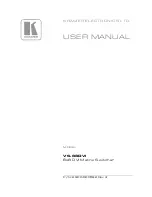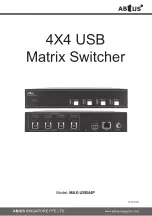
335
Video Conferencing
- for use by dedicated Video Conferencing equipment
and other similar appliances supporting real-time interactive video/audio
services.
Streaming Video
- for use by broadcast or multicast based video content
distribution and other similar applications supporting streaming video
services that require specific network policy treatment. Video applications
relying on TCP with buffering would not be an intended use of this
application type.
Video Signaling
- for use in network topologies that require a separate
policy for the video signaling than for the video media.
Policy
Policy
indicates that an Endpoint Device wants to explicitly advertise that the
policy is required by the device. Can be either Defined or Unknown
Unknown
: The network policy for the specified application type is currently
unknown.
Defined
: The network policy is defined.
TAG
TAG is indicating whether the specified application type is using a tagged or an
untagged VLAN. Can be Tagged ot Untagged
Untagged
: The device is using an untagged frame format and as such does
not include a tag header as defined by IEEE 802.1Q-2003.
Tagged
: The device is using the IEEE 802.1Q tagged frame format
VLAN ID
VLAN ID is the VLAN identifier (VID) for the port as defined in IEEE
802.1Q-2003. A value of 1 through 4094 is used to define a valid VLAN ID. A
value of 0 (Priority Tagged) is used if the device is using priority tagged frames as
defined by IEEE 802.1Q-2003, meaning that only the IEEE 802.1D priority level
is significant and the default PVID of the ingress port is used instead.
Priority
Priority is the Layer 2 priority to be used for the specified application type.One of
eight priority levels (0 through 7)
DSCP
DSCP is the DSCP value to be used to provide Diffserv node behavior for the
specified application type as defined in IETF RFC 2474. Contain one of 64 code
point values (0 through 63).
Auto-negotiation
Auto-negotiation
identifies if MAC/PHY auto-negotiation is supported by the link
partner.
Auto-negotiation
status
Auto-negotiation status
identifies if auto-negotiation is currently enabled at the
link partner. If
Auto-negotiation
is supported and
Auto-negotiation status
is
disabled, the 802.3 PMD operating mode will be determined the operational MAU
type field value rather than by auto-negotiation.
Summary of Contents for NS3702-24P-4S
Page 1: ...NS3702 24P 4S User Manual P N 1072832 REV 00 01 ISS 14JUL14 ...
Page 102: ...102 Figure 4 5 4 LACP Port Configuration Page Screenshot ...
Page 119: ...119 Figure 4 6 4 VLAN Membership Status for Static User Page Screenshot ...
Page 124: ...124 Figure 4 6 6 Private VLAN Membership Configuration page screenshot ...
Page 140: ...140 Figure 4 6 21 Group Name to VLAN Mapping Table Page Screenshot ...
Page 164: ...164 Figure 4 8 2 Multicast Flooding ...
Page 184: ...184 Figure 4 8 15 MLD Snooping Port Group Filtering Configuration Page Screenshot ...
Page 204: ...204 Figure 4 9 6 QoS Egress Port Tag Remarking Page Screenshot ...
Page 209: ...209 QoS Class QoS Class value can be any of 0 7 DPL Drop Precedence Level 0 1 ...
Page 251: ...251 Figure 4 11 3 Authentication Method Configuration Page Screenshot ...
Page 286: ...286 Figure 4 11 11 RADIUS Server Configuration Screenshot ...
Page 290: ...290 Figure 4 11 17 Add User Properties Screen Figure 4 11 18 Add User Properties Screen ...
Page 298: ...298 non committed changes will be lost ...
Page 349: ...349 Figure 4 16 2 PoE Configuration Screenshot ...
















































